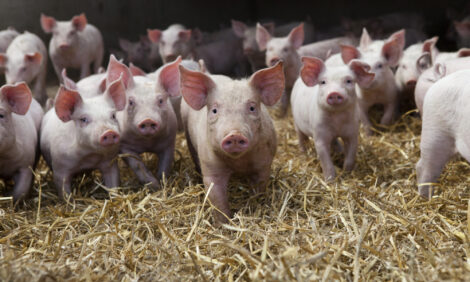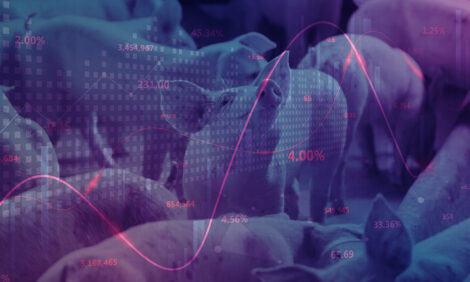



Sapovirus: An emerging swine disease
How does sapovirus impact the pig?What is porcine sapovirus?
Porcine sapovirus is an enteric virus in the same family as norovirus. However, its clinical signs are less severe than norovirus.
“There are a lot of unknowns with sapovirus, but it is thought to be transmitted between pigs through a fecal-oral contamination route, and it persists in the environment once it is established,” said Cary Sexton, DVM with Four Star Veterinary Service based near Kinston, North Carolina.
Good sanitation and overall cleanliness can discourage the pathogen, but good sanitation alone is unlikely to effectively eliminate the disease.
Typical clinical signs are yellow, pasty diarrhea in middle-age farrowing house pigs.
“Sometimes we’ll see the pig make its way through different phases – initially it may have a bacterial infection, then the next wave is a viral load that would typically include rotavirus,” he explained. “When that is subsiding clinically, we may still find those pathogens in clinical samples, but it would be a much different presentation than what we would see with a single rotavirus infection. We wouldn’t see the feces turn to pasty scours with just rotavirus alone.”
Typically, sapovirus may start in just a few pigs with scours present, and it doesn’t appear to have a significant impact early, and samples may only indicate a few positives. But the longer it persists, the more and more pigs begin to scour, reinforcing the fecal-oral exposure route of pig-to-pig transmission.
“Clinically, it looks very similar to how coccidia looks when it hits a farrowing pig early. The pig will get gaunt but may still be nursing,” he said. “It might look like a good nursing pig that has a pasty stool that’s either somewhat stagnant in growth or may be going backwards.”
If you see these symptoms, the first step is to collect fecal samples or tissue samples. Because there is no virus isolation available, testing currently utilizes PCR techniques. The genetic material testing modality won’t tell you if the virus is alive or dead, but between the clinical symptoms and a positive or negative PCR, it will offer a diagnosis.
“A low Ct count means a high viral load, and the higher the load is the more clinical signs you’re going to see in an individual animal,” he said. “ I would say with the intestinal samples you also get the histological diagnosis as well which can also determine this pathogen from other diseases histologically. If you’re finding the lesions inside the intestine on samples with the pathogen, then it’s confirmatory of the problem.”
Your pigs test positive. What’s next?
If you have sapovirus, then whether to vaccine the herd becomes an economic question to answer. Keep in mind that it typically causes more morbidity than mortality. And there is no treatment option available.
- How many litters are affected?
- Which segments of the population are impacted – gilts, young parities or across all parities?
- What’s your disease prevalence?
- Are you retaining the pigs or selling them as weaned pigs?
- Do you get paid for a heavier weaned pig?
- Do the scours affect the grading of the other pigs?
Using that information, you can back into the equation of cost-effectiveness and return on investment to invest in preventative vaccine treatment or increased sanitation techniques.
Beyond the disease, pig producers may want to consider the presentation of scours. They can create some issues with sanitation moving forward because scours are adhered to the crate, so someone will be spending a lot of time cleaning crates. Scours will keep sapovirus in your system and continue the cycle.
“Every farm’s ROI calculation is different, so every producer has to decide if vaccination is right for their operation,” he said.
How does sapovirus impact the pig?
Sapovirus affect a pig’s gut absorption, causing malabsorptive diarrhea. This degrades their efficiency at converting the nutrition they’re receiving from the sow into weight gain for the pig.
“It’s a decrease in efficiency, not unlike what we’d see with a coccidiosis and rotavirus, it’s affecting the efficiency of the intestine absorption, but it’s not a complete loss of absorption,” he said.
Cost of a disease
Swine diarrheal disease complex can shift from causative agent to causative agent with young pigs.
“Bacterial agents can take hold and then viral agents like rotavirus can be a problem, and sapovirus fits in the middle followed by coccidiosis a little bit later in the pig’s life, so it’s kind of like a continuum, much like the respiratory disease complex can occur” he said.
Thus, the more the gut is damaged by infections the more time will be required to heal itself. The gut is a very adaptive organ, but when damaged, the pig is spending more of its energy healing which impacts the efficiency of its nutritional adsorption.
“Every disease a pig’s immune system must manage makes it more vulnerable to other diseases,” he noted. “We must consider the long-term impact to the immune function system. Sapovirus on its own may not impact weight gain long-term, but as part of a disease complex, it could be much more significant.”
Today, the industry hasn’t studied sapovirus enough to determine its overall economic impact.
“Unless a farm is monitoring individual weights, it’s unlikely they would know the true cost of sapovirus,” he said. “But it’s more of a clinical impression that a batch of pigs are a little bit smaller, and maybe they’re a half a pound lighter.”
The exception would be a more severe outbreak when an entire farrowing house is affected. Then, it’s possible to identify weight losses and outline an economic loss to the farm.
Dr. Sexton expects sapovirus to clear and resolve in a few days and says he watches for the “bloom” to come back to the pig if no additional pathogens are present to lead to the diarrhea disease complex. Then you can look and compare a sapovirus litter to a clean litter to see if there’s a visual difference in size.
To vaccinate for not?
If a producer does decide to vaccinate, an autogenous vaccine is the only current option.
“The previous generation of the autogenous vaccines mantra was grow it, kill it, bottle it,” said Dr. Sexton. “And that works really well for bacterial diseases and for certain viral diseases that are better understood and cell culture adapted. But for newer diseases that have not become culture adapted, we’re relying basically on genetic sequencing and then producing the surface protein that the pig’s body still recognizes as an antigen.”
As a result, it’s not the whole pathogen in the bottle, like we normally think of an autogenous vaccine. Rather, it’s a subunit vaccine that will signal or produce the same immune response in the body as the intact bacteria or virus would do.
Dr. Sexton also noted that using the sapovirus contaminated fecal material for feedback is contraindicated because it can cause other negative health conditions to occur.









